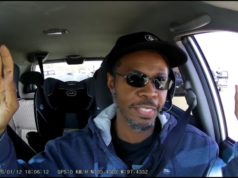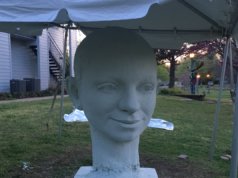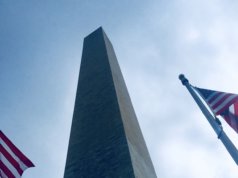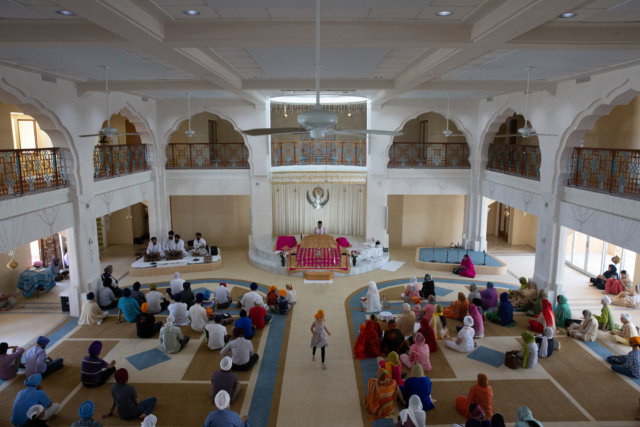

By Allie Bice, Abby Bitterman and Ashley Mackey | News21
NEW YORK — “If you attack one of us, you attack all of us.”
Rabbi Rick Jacobs, president of the New York-based Union for Reform Judaism, wasn’t just speaking for Jewish people. As religious hate crimes rise in America, faith groups across the country have come together to protect themselves and help others who have been been attacked for their religion.
In Philadelphia, after vandals toppled and desecrated at least 275 headstones at the historic Jewish Mount Carmel Cemetery in February 2017, hundreds of volunteers, including members of other faiths, helped with the cleanup, according to the Jewish Federation of Greater Philadelphia.
In Victoria, Texas, after an arsonist destroyed the Victoria Islamic Center in January 2017, members of the Jewish community in the city of 60,000 offered the keys to their temple, and Christian churches offered spaces so Muslims could worship until the mosque was rebuilt.
In Tennessee, after the Islamic Center of Murfreesboro was spray-painted with anti-Islamic slurs and defaced with bacon in July 2017, hundreds from the community provided cleaning supplies and donations to the cleanup area, said Saleh Sbenaty, a member of the center’s board of trustees.
“We’ve seen faith communities come together and take a clear stance against hatred,” said Faizan Syed, executive director of the Missouri chapter of the Council for American-Islamic Relations.

Hate crimes reportedly rising, first time since 2010
Jewish and Muslim communities are the most targeted religious groups, according to FBI data, and advocacy organizations report a rise in hate crimes during the past year.
Anti-Semitic incidents reported to the Anti-Defamation League increased from 1,267 in 2016 to 1,986 in 2017, according to the ADL. For the first time since 2010, acts against the Jewish community were reported in all 50 states last year.
“Racists and white supremacists and other anti-Semites have felt more free to speak out and voice their hatred for minorities, including Jews,” said Aryeh Tuchman, associate director for the ADL’s Center on Extremism.
Anti-Muslim hate crimes in the U.S. rose in the past year from 260 to 300 incidents, according to figures from the Council on American-Islamic Relations (CAIR).
Harassment was recorded as the most frequent form of anti-Semitism, according to a 2017 ADL audit. Physical damage, destruction or vandalism to mosques were the most frequent anti-Muslim hate crimes, according to a 2018 report from CAIR.
Leaders of 20 mosques, synagogues and gurdwaras – which are places of worship for Sikhs, who often are mistaken for Muslims – around the country also found religious groups are amping up security, hosting self-defense classes and educating neighbors about religions, with simplified instruction and open houses.
Young Israel of Phoenix added security cameras after scrolls were stolen from its synagogue. The Islamic Center of Murfreesboro began hiring one off-duty deputy for larger prayer services after its mosque was defaced. Temple Beit Torah in Colorado Springs, Colorado, improved relations with local law enforcement after the temple was spray-painted with anti-Semitic slurs.
Allison Miller of St. Louis, a stay-at-home mom and convert to Islam, created four-hour self-defense classes for Muslim women after she was physically attacked while wearing a hijab outside a Kevin Hart comedy show in 2015.
Imam Kifah Mustapha, the religious leader of the Prayer Center of Orland Park and chairman of the Illinois Council of Imams and Scholars, met with 16 fellow religious leaders in 2017 to discuss security measures in response to an increase in violence against Muslim houses of worship and the rise of right-wing extremist groups, he said.
Prayer Center of Orland Park has increased its security since 2017 by only allowing visitors to enter and exit certain doors and hiring a security staff, among other measures. Mustapha said coordination with other religious groups is now of greater importance, “regardless of what kind of congregations they are.”
In the past decade, safety has been such a priority for synagogues, temples, mosques and churches that several companies now specialize in security measures for religious institutions. Firms teach rabbis, imams and priests to handle threats, as well as to train volunteers in congregations to spot suspicious behaviors, serving as a voluntary security force.
Advocates say far more work is needed to combat the increase in number of hate incidents, as white supremacists are becoming more visible and emboldened.
Hatred of Jewish people persists
Historically, anti-Semitic hate crimes have been the most frequent form of religious-based hate in America, according to FBI data, and lately they have been increasing.
The number of anti-Semitic hate incidents in 2017 were the second highest since the ADL began collecting such information in 1979. The data show an uptick about 2004, then a steady decrease until 2014, when the numbers began rising again.
“We feel confident in saying that a general level of bigotry and xenophobia and general hatred and intolerance has increased in our country, at the very least since the run-up to the 2016 election,” Tuchman of the ADL said.
Jacobs, with the Union for Reform Judaism, called the August 2017 Unite the Right rally in Charlottesville, Virginia, the epicenter of hate. Hundreds of white supremacists, racists and anti-Semites – who came from around the country to protest the city’s decision to remove a Confederate statue – “joined together in their hatred,” shouting such slogans as “Jews will not replace us!” and “Blood and soil!” One woman was killed and dozens injured when a car was driven into a crowd of counterprotesters.
For Jacobs, the silver lining to the darkness of Charlottesville was the reaction from local faith communities.
“They’re in the midst of the hatred and the bigotry and the militia and the white supremacists and anti-Semites,” Jacobs said. “The faith community stood on the front lines. They stood together. They stood nonviolently.”
Congregation Beth Israel, a Charlottesville synagogue, didn’t cancel its services on the day of the rally, though congregants told News 21 they were threatened by the militias and bands of armed bigots marching around the temple.
Synagogue leaders became aware of potential threats weeks before the rally took place. An armed guard was hired to stand outside during Saturday morning Shabbat service, according to Alan Zimmerman, the president of the congregation.
“It has also brought us closer to the national and worldwide Jewish community because we saw so much support for our congregation come in from Jewish communities across the U.S., and from many non-Jews as well,” he said.
National leaders from all religious faiths condemned the violence, with many devoting their next Sunday sermons or messages to it.
The Rev. Phil Woodson, associate pastor at First United Methodist Church in Charlottesville, said he was “completely oblivious” to the white supremacy in the country until a few years ago, and the violent rally was a moment of awakening for him and other religious leaders.
“White supremacy and this culture of racism is America’s original sin,” Woodson said. “We hear that talked about from a lot of very prophetic faith and civic leaders. It is a deep, deep wound that has never healed because we’ve never got down into it.”
But events like the Unite the Right rally aren’t the norm for anti-Semitic hate. Most perpetrators damage property, threaten or harass places of worship.
Jack McDevitt, director of Northeastern University’s Institute on Race and Justice, said anti-Semites “are more likely to attack a synagogue or cemetery because you may not be able to know that a person is Jewish, but you know that a synagogue is Jewish.”
Rabbi Jacobs, who leads almost 900 reformed synagogues across the country, stressed that graffiti and other crimes against Jewish property are “strong acts of anti-Semitism.” Physical desecration of a cemetery or a building is in no way innocent, he said.
“When a swastika, for example, is painted on a synagogue in Alameda, California, right before the high holidays, it might sound to someone as a less harsh and a less menacing or threatening act, but you have to imagine what a swastika symbolizes,” he said.
Jacobs said the Jewish community has at times felt vulnerable and isolated, but that’s not the case now – although working together against hate didn’t happen overnight.
After decades of different faiths working together on other issues, such as affordable housing or combating poverty, “you build relationships,” he said.
“You build trust and you build bonds that make you aware of the pain that others experience and the vulnerability,” Jacobs said. “It is our responsibility to stand against it.”
Galvanizing events lead to anti-Islamic hate
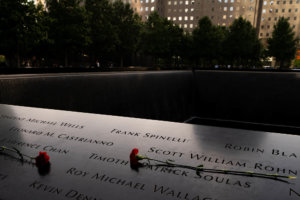
Patterns of hatred for Muslims are rooted in recent history — the 9/11 terrorist attacks, Barack Obama’s election, the raucous 2016 presidential election and President Donald Trump’s January 2017 executive order barring people from seven Muslim-majority countries from entering the U.S., according to advocates and experts.
“Galvanizing events do matter,” said Ilir Disha, assistant professor at the Borough of Manhattan Community College in New York, who conducted extensive research on anti-Muslim and anti-Arab hate crimes after 9/11.
Disha’s research showed the number of hate crimes against Muslims reported to the FBI increased in the eight months after 9/11. But then anti-Muslim hate crimes fell to historic lows and stayed that way until 2008, said Syed of CAIR Missouri. But after Obama’s election, anti-Islamic incidents started to creep up and fall again until the 2016 election. When Obama campaigned for the U.S. Senate, there were already conspiracies circulating about potential ties to the Islamic faith — and they became stronger when they ran for president.
“(We) saw the merging of anti-Muslim bigoted rhetoric and anti-Muslim bigoted organizations become politicized and become a tool, particularly for one party,” Syed said. “We now see a dramatic increase in anti-Muslim hate crimes in the country today.”
The most prevalent motive for anti-Muslim incidents is the victim’s ethnicity or national origin, which accounted for 32 percent of recorded bias incidents against Muslims in 2017. The number of anti-Muslim incidents reported to CAIR increased by 386 in 2016 to a total of 2,599 in 2017, according to the organization’s most recent report.
In a 2018 report from CAIR, Muslim leaders wrote that national leadership matters: “The 45th president’s brazen display of animosity and prejudice has emboldened individuals seeking to express their bias and made the very word ‘Trump’ an encapsulating and potent symbol of wide-ranging racial and religious animus.”
About 2 a.m. on Jan. 28, 2017 – the day after Trump’s executive order, which had been dubbed the “Muslim travel ban” – the imam of the Victoria Islamic Center woke up to check the mosque’s security system and saw that the doors were open.
Osama Salah Hassan rushed over after the center’s president, Dr. Shahid Hashmi, had already arrived. The mosque already was ablaze when Hashmi arrived, and the news soon spread through the congregation.
“I drove over and then after that everybody else drove over there and we just watched it from across the street, just watched it burned down completely for the next three or four hours,” Hashmi said.
On July 16, 2018, Marq Vincent Perez, 26, was convicted on a hate-crime charge, federal arson and possession of unregistered explosives for the burning of the Texas mosque.
The Islamic community did not celebrate that conviction, Hashmi said.
“We feel sorry for that one person,” he said. “To carry that much hate to destroy a place of worship.”
After the fire, churches and a synagogue in Victoria offered space for the mosque’s members to pray, acts of goodwill that didn’t surprise Hashmi.
“After 9/11, all the support came in at that time,” Hashmi said. “And then we have had interfaith relations with the community, and I didn’t expect anything but such a good response from the local community.”
If anything, he said, the fire brought the religious communities in Victoria together rather than tore them apart.
A new mosque on the same land is scheduled to open in late August, thanks to nearly 24,000 people from around the world donating $1.13 million to a GoFundMe account. It will have more security measures – cameras, lights and landscaping designed to thwart attacks by vehicles.
Targets of anti-Muslim hate aren’t just mosques
Fawad Mohammadi, a Muslim immigrant who worked as an interpreter for U.S. forces in Afghanistan, survived his time in the war unscathed. He routinely accompanied troops under fire, including on medevac missions where he saw dead and seriously wounded Americans and Afghans.
“I was really worried about losing part of my body (in combat),” Mohammadi said. “I was like … if I die, it’s OK, but I don’t want to lose any part of my body.”
But, on March 6, he was back in a helicopter – this time as a patient bound for the trauma room at a Portland hospital.
The incident began with a fender-bender in a Walgreens parking lot in Lincoln City, Oregon. When Mohammadi got out of his car to inspect the damage, the other driver, Perry George Nicolopoulos, 68, put his car in reverse and drove straight into him, pinning his legs between the two vehicles. Six inches of Mohammadi’s right leg had to be amputated.
Nicolopoulos was initially charged with attempted murder, drunken driving and hit-and-run, but prosecutors also are seeking to designate it as a religious-based hate crime under Oregon statutes, according to Lincoln County court records.
Money for Mohammadi’s surgeries was donated through a GoFundMe account set up by his manager at the Lake Oswego, Oregon, deli where he worked before the accident. Mohammadi, who loves to cook, had the nickname “Soup King” and was on his way to becoming an assistant manager.
The office manager at Palisades Marketplace in Lake Oswego, Stephanie Ballard-Agramonte, raised $109,000 for Fawad’s recovery as of mid-August. Co-workers, customers and strangers from across the country, not just Muslims, donated when they heard about the incident.
Sikhs mistakenly targeted as Muslims
Prabhjot Singh, a physician living in the sprawling Harlem neighborhood of New York City, was walking on a September evening in 2013 when more 20 men beat him and threw a bike at him.
It was the third time he’d been physically attacked since 9/11, Singh said.
The men shouted anti-Muslim slurs at Singh, calling him a terrorist and Osama Bin Laden. Singh suffered a fractured jaw and other injuries before neighbors intervened. The attack was investigated as a hate crime because of the racial slurs and labeled as one of mistaken identity — a label Singh and other Sikhs reject.
“The idea that any group essentially is maligned on the basis of their identity – whether you’re Muslim or you’re Mormon – wouldn’t be a good reason, period, to be attacked,” Singh said. “It also implies that we really understand the motives of people who are taking part in a hate crime.”
In addition to being targets of anti-Muslim hate, Sikhs specifically have been targeted for their religion. In 2013, the FBI included anti-Sikh hate in its annual crime report for the first time, and reported six hate incidents against Sikhs in both 2015 and 2016. The Sikh Coalition has counted more 175 incidents of hate crimes against Sikhs since 2001.
Simran Jeet Singh, senior religion fellow with the Sikh Coalition in New York City, said the organization has received on average one report of a hate incident per week in 2018.
Every minority group has been at increased risk since the 2016 presidential campaign, he said, because violence against these groups is becoming more normalized.
“What I’ve experienced are people willing to say things that they weren’t saying before,” Simran Singh said.
He said slurs have changed over time depending on world events. Around the time of the Gulf War in 1990, he was called Saddam. After 9/11, it was al-Qaida, and today, it’s ISIS and terrorist. He noted that people have been calling him Muslim as a derogatory slur recently, and he credits that to the racialization of Islam.
“For me as a Sikh, the aspects of my religious identity are so personal that if someone was to try and violate them in any way – that’s not an attack just on those articles, it’s not just an attack on me as an individual, it’s something much deeper than that,” Simran Singh said.
Moving forward: A push for tolerance
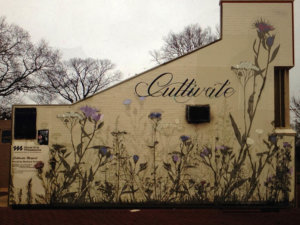
Headstones of the historic Jewish Mount Carmel Cemetery in Philadelphia were restored after they were vandalized in 2017, said Laura Frank, public-relations manager of the Jewish Federation of Greater Philadelphia. Nearly 300 volunteers aided the project.
Next to the cemetery, in a nearby park, is a mural titled “Cultivate Respect.” It incorporates colorful flowers, butterflies and the word “Cultivate” in cursive.
The mural was in the works before the headstones were damaged, but Frank said themes of tolerance and inclusivity were added in response to the vandalism.
“It was a very big moment for all of us to come together and just to stand against vandalism,” Frank said.
(Editor’s note: Scott Bourque, Bryce Spadafora and Lenny Martinez Dominguez contributed to this report. Allie Bice and Scott Bourque are Hearst Foundation Fellows, Abby Bitterman is an Ethics and Excellence in Journalism Fellow, and Ashley Mackey is a Knight Foundation Fellow.)









